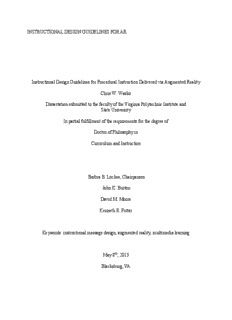Table Of ContentINSTRUCTIONAL DESIGN GUIDELINES FOR AR
Instructional Design Guidelines for Procedural Instruction Delivered via Augmented Reality
Chris W. Wasko
Dissertation submitted to the faculty of the Virginia Polytechnic Institute and
State University
In partial fulfillment of the requirements for the degree of
Doctor of Philosophy in
Curriculum and Instruction
Barbra B. Lockee, Chairperson
John K. Burton
David M. Moore
Kenneth R. Potter
Keywords: instructional message design, augmented reality, multimedia learning
May 8th, 2013
Blacksburg, VA
INSTRUCTIONAL DESIGN GUIDELINES FOR AR
Instructional Design Guidelines for Procedural Instruction Delivered via Augmented Reality
Chris W. Wasko
Abstract
Augmented reality, defined as a real-time direct or indirect view of a physical real-world
environment that has been enhanced by adding digital computer generated information to it, is
rapidly developing in terms of associated hardware (wearable displays, wireless mobile devices)
and software (development platforms). AR enhanced instruction has been shown to provide
cognitive and psychomotor support during procedural learning and has been shown to use both
words and pictures when delivering instructional content. A set of message design guidelines,
created using a design and development research approach, can be used by novice designers to
effectively manage the use of words and pictures while developing instructional applications for
AR.
INSTRUCTIONAL DESIGN GUIDELINES FOR AR
Dedication
To Erin, Nancy, and Ron
iii
INSTRUCTIONAL DESIGN GUIDELINES FOR AR
TABLE OF CONTENTS
Chapter 1: Introduction and Need for the Study...................................................................1
Brief Introduction to AR..................................................................................................1
Brief Introduction to Design and Development Research...............................................3
Need for Study.................................................................................................................4
Purpose of Study.............................................................................................................7
Chapter 2: Review of Literature..............................................................................................8
Introduction.....................................................................................................................8
Augmented Reality..........................................................................................................8
Introduction.........................................................................................................8
Taxonomy............................................................................................................9
Associated Attributes.........................................................................................11
Entry Points........................................................................................................11
Review of Instructional Applications of Augmented Reality............................14
Analysis of Reported AR Instructional Uses.....................................................15
Observation 1: AR and procedural learning..........................................16
Overview...................................................................................16
Cognitive and psychomotor phases............................................16
Supporting evidence...................................................................18
Observation 2: words and pictures in AR...............................................22
Implications.......................................................................................................22
Cognitive Theory of Multimedia Learning...................................................................23
iv
INSTRUCTIONAL DESIGN GUIDELINES FOR AR
Introduction.......................................................................................................23
Underlying assumptions....................................................................................24
Dual channel assumption.......................................................................24
Limited capacity assumption. ................................................................26
Active processing assumption................................................................27
How learning occurs according to CTML.........................................................28
Summary............................................................................................................28
Limitations of Multimedia Learning..............................................................................29
Evidence Based Principles Relating to the Design of Multimedia Instruction..............31
Multimedia principle..........................................................................................32
Contiguity principle...........................................................................................34
Modality principle..............................................................................................35
Redundancy principle........................................................................................36
Coherence principle...........................................................................................37
Personalization principle....................................................................................38
Summary............................................................................................................39
Research Based Evidence..............................................................................................41
Evidence for the multimedia principle...............................................................41
Evidence for the contiguity principle.................................................................44
Evidence for the modality principle...................................................................46
Evidence for the redundancy principle................................................................48
Evidence for the coherence principle..................................................................50
v
INSTRUCTIONAL DESIGN GUIDELINES FOR AR
Evidence for the personalization principle..........................................................52
Summary..............................................................................................................53
Design and Development Research.................................................................................54
Overview..............................................................................................................54
Main procedures...................................................................................................54
Representative examples......................................................................................57
Summary..............................................................................................................57
Research Questions..........................................................................................................58
Chapter 3: Research Methodology...........................................................................................59
Introduction......................................................................................................................59
Research Design: Design and Developmental Research..................................................59
Procedures........................................................................................................................61
Selection of theoretical components.....................................................................61
Multimedia principle.................................................................................61
Contiguity principle..................................................................................62
Modality principle.....................................................................................63
Redundancy principle................................................................................63
Coherence principle..................................................................................64
Personalization principle...........................................................................64
Selection Criteria..................................................................................................65
Selection criteria #1....................................................................................65
Selection criteria #2....................................................................................66
vi
INSTRUCTIONAL DESIGN GUIDELINES FOR AR
Selection criteria #3...................................................................................66
Selection criteria #4....................................................................................67
Summary....................................................................................................67
Operationalization of Components in the Guidelines............................................69
Validation of the Guidelines..................................................................................69
Evaluation Rubric.......................................................................................71
Presentation of the Guidelines................................................................................71
Conclusion.........................................................................................................................72
Chapter 4: Constructing Guidelines for Procedural Instruction Delivered via AR….….....74
Introduction........................................................................................................................74
Guideline Design and Development..................................................................................77
Model Selection.....................................................................................................77
Assess Needs to Identify Goals..............................................................................78
Conduct Instructional Analysis and Analyze Learners and Contexts.....................78
Write Performance Objectives...............................................................................79
Develop Instructional Strategy..............................................................................80
Develop and Select Instructional Materials...........................................................80
Design and Conduct Formative Evaluation...........................................................82
Design and Conduct Summative Evaluation.........................................................82
Conclusion.........................................................................................................................83
Chapter 5: Expert Review..........................................................................................................84
Introduction.......................................................................................................................84
vii
INSTRUCTIONAL DESIGN GUIDELINES FOR AR
Qualitative Data Analysis..................................................................................................85
Overall Perspectives..........................................................................................................85
Coding Results..................................................................................................................86
Resultant Changes.............................................................................................................89
Theme 1: Guideline Design Issues........................................................................89
Theme 1: Resolution of Guideline Design Issues..................................................90
Theme 2: Content Level Issues..............................................................................90
Theme 2: Resolution of Content Level Issues.......................................................91
Theme 3: Content Detail Issues.............................................................................92
Theme 3: Resolution of Content Detail Issues......................................................94
Revision Summary............................................................................................................95
Conclusion........................................................................................................................96
Chapter 6: Observations and Summary...................................................................................98
Purpose of the Study.........................................................................................................98
Study Summary.................................................................................................................98
Contribution of Study........................................................................................................99
Theoretical Implications..................................................................................................100
Practical Implications......................................................................................................102
Next Steps.......................................................................................................................103
References..................................................................................................................................104
viii
INSTRUCTIONAL DESIGN GUIDELINES FOR AR
List of Appendices
Appendix A: Table 1..................................................................................................................117
Appendix B: Table 4..................................................................................................................122
Appendix C: Table 8..................................................................................................................128
Appendix D: Expert Review Request........................................................................................130
Appendix E: Evaluation Rubric.................................................................................................131
Appendix F: Request for Permission to Use Image...................................................................135
Appendix G: IRB Approval Memo ….......................................................................................136
Appendix H: Revised Guidelines..............................................................................................137
ix
INSTRUCTIONAL DESIGN GUIDELINES FOR AR
List of Tables
Table 1: Summary of Publications where AR is Used as an Instructional Delivery Method.......15
Table 2: Cognitive and Psychomotor Aspects of AR....................................................................17
Table 3: Summary Description of Multimedia Principles.............................................................40
Table 4: Summary of Research Based Evidence...........................................................................53
Table 5: Summary of Theoretical Component Selection Criteria.................................................68
Table 6: Expert Reviewers............................................................................................................70
Table 7: Expert Feedback Overview.............................................................................................87
Table 8: Summary of Guideline Revisions...................................................................................96
x
Description:Based Principles Relating to the Design of Multimedia Instruction..31 Initially, users experienced AR by wearing a complex optical see-through . Game Salad and M.I.T. App Inventor are available for use by those who

